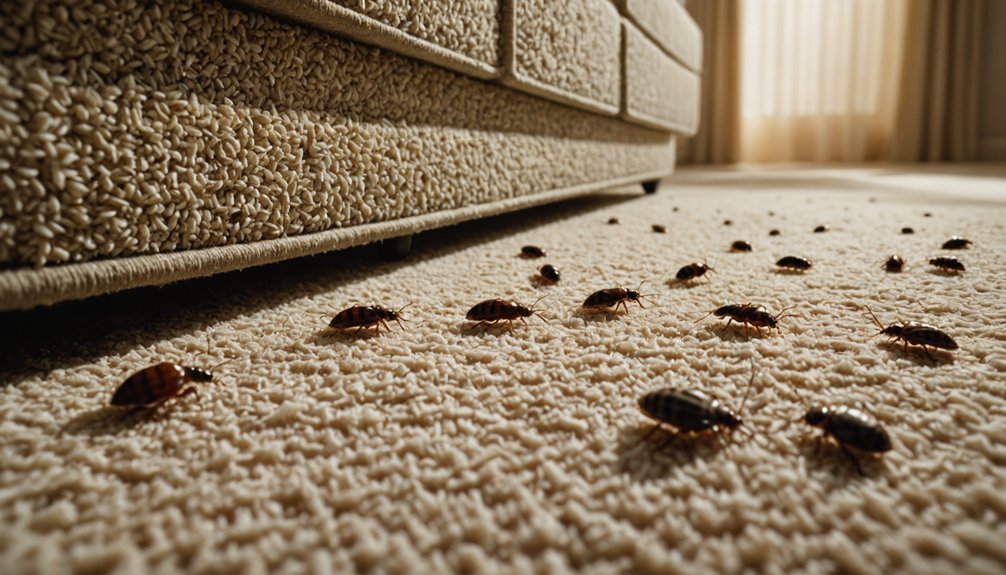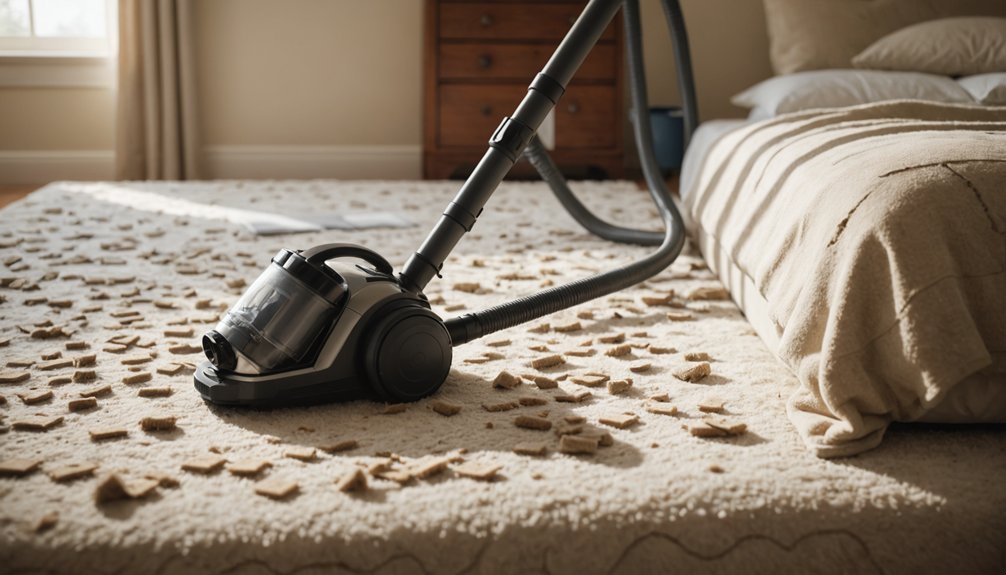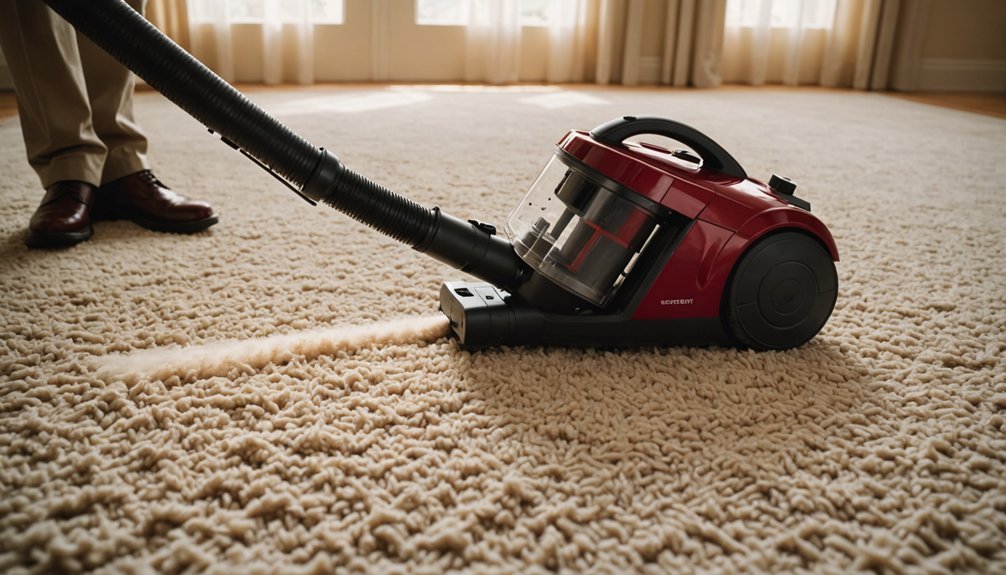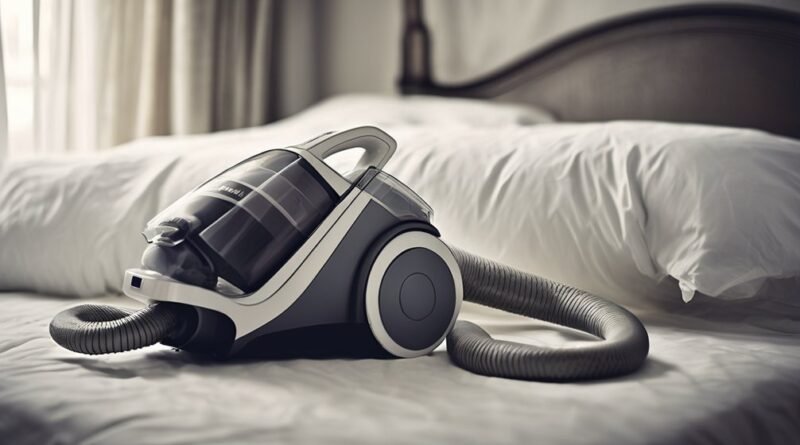Vacuuming for Bed Bugs: Does It Really Work?
If you’re dealing with bed bugs, you’ve probably wondered whether your vacuum cleaner could be the answer to your problems. While vacuuming can remove up to 80% of these persistent pests from visible surfaces, there’s more to the story than meets the eye. You’ll need to understand both the potential and limitations of this method before deciding if it’s the right approach for your bed bug battle.
Key Takeaways
- Vacuuming can reduce bed bug populations by up to 80% through direct physical removal but cannot eliminate infestations completely.
- Commercial-grade HEPA vacuums with sealed systems are most effective, while regular household vacuums may be insufficient for bed bug removal.
- Eggs are resistant to vacuuming due to their cement-like coating, and bugs hiding deep in cracks often escape vacuum suction.
- Effective vacuuming requires multiple sessions, proper attachments, and careful attention to seams, crevices, and joints where bugs hide.
- Proper disposal of vacuum contents in sealed bags is crucial to prevent reinfestation and spread of bed bugs.
The Science Behind Vacuum-Based Bed Bug Removal

While many people think vacuuming alone can eliminate bed bugs, understanding the science behind vacuum-based removal reveals both its benefits and limitations.
These reddish-brown insects lurk in mattresses and furniture while waiting to feed on human blood.
You’ll find that bed bugs naturally cling tightly to fabrics and hide in cracks, making targeted suction essential for their removal.
The physics of vacuum-based removal is complex – too much suction pressure can actually cause bugs to scatter rather than be captured.
That’s why you’ll need to use gentle, controlled suction with specialized attachments like crevice tools.
Effective bed bug removal requires precise vacuum control and proper tools to prevent spreading the infestation further.
Commercial-grade HEPA vacuums with sealed systems work best, as they prevent bugs from escaping during the process.
Research shows this method can remove up to 34% of bed bugs initially and 95% over repeated sessions, though complete elimination requires about 5.5 hours of thorough vacuuming per furniture piece.
Key Benefits and Limitations of Vacuuming

You’ll find that vacuuming can quickly reduce bed bug populations by up to 80% through direct physical removal of insects, eggs, and debris.
While vacuum-based removal offers immediate results and helps prevent spreading, you must understand its limitations, as it won’t reach bugs hiding deep in cracks or kill all eggs.
Your vacuum can be a valuable tool in bed bug management, but it’s most effective when you combine it with other treatment methods like heat or chemical applications. Experts emphasize using a multi-faceted approach to effectively disrupt bed bug life cycles.
Quick Population Reduction
Targeting bed bugs with a vacuum cleaner can swiftly reduce their population by removing large clusters, individual insects, and debris from exposed surfaces.
When you vacuum before applying other treatments, you’ll improve your chances of successful control by eliminating a significant portion of the infestation immediately.
Using a vacuum is particularly effective when bed bugs are still clustered together, allowing you to remove large groups at once.
For best results, you’ll want to use a vacuum with HEPA filtration, which helps contain allergens and small particles while protecting indoor air quality.
However, be aware that vacuuming won’t kill all life stages – eggs are especially resistant due to their cement-like coating that helps them stick firmly to surfaces.
A stiff brush attachment is essential for thoroughly cleaning carpets and upholstered surfaces where bed bugs commonly hide.
Physical Removal Advantages
Because physical removal directly reduces bed bug populations, vacuuming offers several key advantages in the battle against these persistent pests.
You’ll find it’s particularly effective on fabric surfaces like mattresses, carpets, and box springs, where both bugs and eggs can be efficiently removed. Research from Virginia Tech shows that bed bug eggs are easily removed from fabric surfaces. This method also helps eliminate shed skins and feces, making it easier to monitor treatment progress and reduce potential hiding spots.
You can maximize vacuuming effectiveness by removing dust covers and upholstery to access concealed bugs, though you’ll need to be careful not to damage furniture supports.
While it’s an excellent tool for quick population reduction and supporting integrated pest management, remember that vacuuming alone won’t eliminate established infestations.
You’ll need proper filtration and disposal methods to prevent bugs from escaping during the process.
Practical Application Constraints
While vacuuming serves as a valuable tool for bed bug control, several practical constraints affect its overall effectiveness. You’ll find that it’s a labor-intensive process requiring thorough inspection and repeated treatments to achieve any meaningful results.
The method becomes less effective in cluttered spaces where bed bugs can hide in hard-to-reach spots. Early intervention through vacuuming is essential since bed bugs can survive for months without feeding.
- When you vacuum mattress seams and furniture joints, some bed bugs will cling tightly to rough surfaces, making them difficult to dislodge even with powerful suction.
- You’ll need to regularly empty and seal vacuum contents outside your home to prevent reinfestation.
- Your household vacuum mightn’t be sufficient – commercial-grade units with HEPA filters and specialized attachments work best for targeting bed bugs in cracks and crevices.
Best Practices for Effective Vacuum Treatment

To effectively eliminate bed bugs through vacuuming, you’ll need to follow specific practices that maximize both removal and mortality rates.
Start by removing dust covers and fabric linings to access hidden bugs. Focus on seams, crevices, and joints using narrow vacuum attachments for tight spaces.
You’ll want to maintain consistent vacuum pressure of around -982 mbar and keep temperatures near 30°C when possible. Plan for multiple sessions, as you’ll only remove about one-third of bugs initially.
Daily vacuuming for up to 34 days may be necessary for 95% elimination. Use a vacuum with strong, steady suction and HEPA filters to contain allergens.
Always seal and properly dispose of vacuum bags to prevent reinfestation, and clean your equipment regularly for peak performance.
Integrating Vacuuming With Other Control Methods
Although vacuuming alone won’t eliminate bed bugs completely, it plays an essential role in integrated pest management (IPM) programs.
When you combine vacuuming with other control methods, you’ll greatly improve your chances of successful eradication. It’s particularly effective when used before and after chemical treatments, heat applications, or steam cleaning.
- Vacuum thoroughly before applying pesticides to reduce the bug population and make chemical treatments more effective.
- Use your vacuum in conjunction with mattress encasements to remove bugs from surrounding areas while the encasement traps any remaining insects.
- Follow up heat or steam treatments with vacuuming to remove dead bugs, eggs, and debris from treated areas, preventing potential reinfestation.
For best results, you’ll need to maintain consistent vacuuming as part of a thorough treatment approach while cooperating with pest control professionals.
Essential Equipment and Technical Requirements
Selecting the right vacuum equipment is essential for effective bed bug control. You’ll need a commercial-grade vacuum with a HEPA filtration system that captures over 99% of particles larger than 0.3 microns, including bed bugs and their eggs.
Look for models with sealed filter plugs and secure hoses to prevent pest escape during use and disposal. Your vacuum should include specialized attachments like crevice tools and brushes to access common hiding spots in mattress seams, furniture edges, and baseboards.
Essential vacuum attachments and sealed designs ensure thorough pest removal while preventing bed bugs from escaping during treatment.
Don’t settle for regular household vacuums – dedicated pest control models offer better containment and durability. They’re built with airtight seals and maintain strong suction even with prolonged use.
Remember to keep this equipment separate from your regular cleaning tools to prevent cross-contamination.
Safety Measures and Disposal Guidelines
You’ll need to follow strict vacuum cleaning protocols, including using dedicated equipment with HEPA filters and sealing nozzles between rooms to prevent bed bug spread.
For proper disposal, immediately seal and double-bag used vacuum contents, then dispose of them in outdoor bins while treating the vacuum itself with hot soapy water or insecticidal dust.
To prevent cross-contamination, keep your vacuuming confined to known infested areas, and never transport unsealed equipment through clean zones.
Proper Vacuum Cleaning Protocol
Three critical safety measures form the foundation of proper bed bug vacuum cleaning protocol.
You’ll need to wear protective gear, use only vacuum cleaners with disposable bags, and handle contaminated materials with extreme care.
Before you begin, apply diatomaceous earth to surfaces, which will help kill any bugs collected in the vacuum bag.
- Start at the highest points of infestation and work your way down, focusing on mattress seams, box springs, and bed frames.
- Move systematically through furniture joints, carpet edges, and wall perimeters, paying special attention to cracks and crevices.
- Take the vacuum outside immediately after use, seal the bag in plastic, and dispose of it far from your living space.
Remember to clean your vacuum’s exterior thoroughly and store it in a sealed plastic bag between uses.
Vacuum Disposal Best Practices
Proper disposal of vacuum bags and contaminated materials is essential for preventing bed bug reinfestation.
You’ll need to seal the vacuum bag tightly with tape and place it inside a sturdy plastic bag for double containment. Don’t store these bags inside your home – take them directly to outdoor trash bins.
If you’re disposing of infested furniture, wrap it completely in plastic, seal all openings, and damage it to prevent others from salvaging it.
Don’t forget to label these items clearly as bed bug-infested.
After vacuuming, clean all components thoroughly with hot soapy water, including hoses and attachments.
You’ll want to dispose of the cleaning water immediately to prevent pest survival in drains.
Check your local regulations, as some areas require special handling for pest-contaminated waste.
Cross-Contamination Prevention Methods
Thorough cross-contamination prevention starts with isolating bed bug-infested materials from clean areas during and after vacuuming.
You’ll need to immediately seal vacuumed contents in plastic bags and store them outdoors or in isolated areas until proper disposal.
Don’t shake contaminated items, and always handle vacuum bags with gloves to avoid spreading bed bugs on your clothing or hands.
- Place infested fabrics directly into sealed plastic bags before transporting them to laundry facilities.
- Install door sweeps and seal cracks around baseboards to restrict bed bug movement between rooms.
- Use high-quality mattress encasements and bed leg interceptors to trap existing bugs and prevent their spread to other areas.
Remember to clean your vacuum equipment thoroughly after use, focusing on the nozzle, hose, and exterior surfaces where bed bugs might cling.
Real-World Success Rates and Expectations
When evaluating vacuuming as a bed bug control method, real-world success rates paint a modest picture of its effectiveness. You’ll find that while vacuuming can remove a significant portion of visible bed bugs, it’s not a standalone solution. Professional pest controllers report using vacuuming as part of their treatment protocols about 48% of the time, indicating its value as a supplementary method.
| Method | Effectiveness | Best Use Case |
|---|---|---|
| Vacuum Alone | Limited | Initial Population Reduction |
| With Chemical Treatment | Moderate | Pre/Post Treatment |
| With Heat Treatment | High | Extensive Control |
To achieve the best results, you’ll need to combine vacuuming with other treatment methods. While vacuuming can immediately reduce bed bug populations, eggs and hidden bugs often survive, requiring additional control measures for complete elimination.
Conclusion
You’ll find vacuuming can be a valuable first step in your bed bug control strategy, but don’t rely on it alone. While you can remove up to 80% of visible bugs with proper equipment and technique, you’ll need to combine this method with other treatments for complete elimination. Remember to use a HEPA-filtered vacuum, follow safe disposal practices, and maintain consistent monitoring to achieve the best results.

